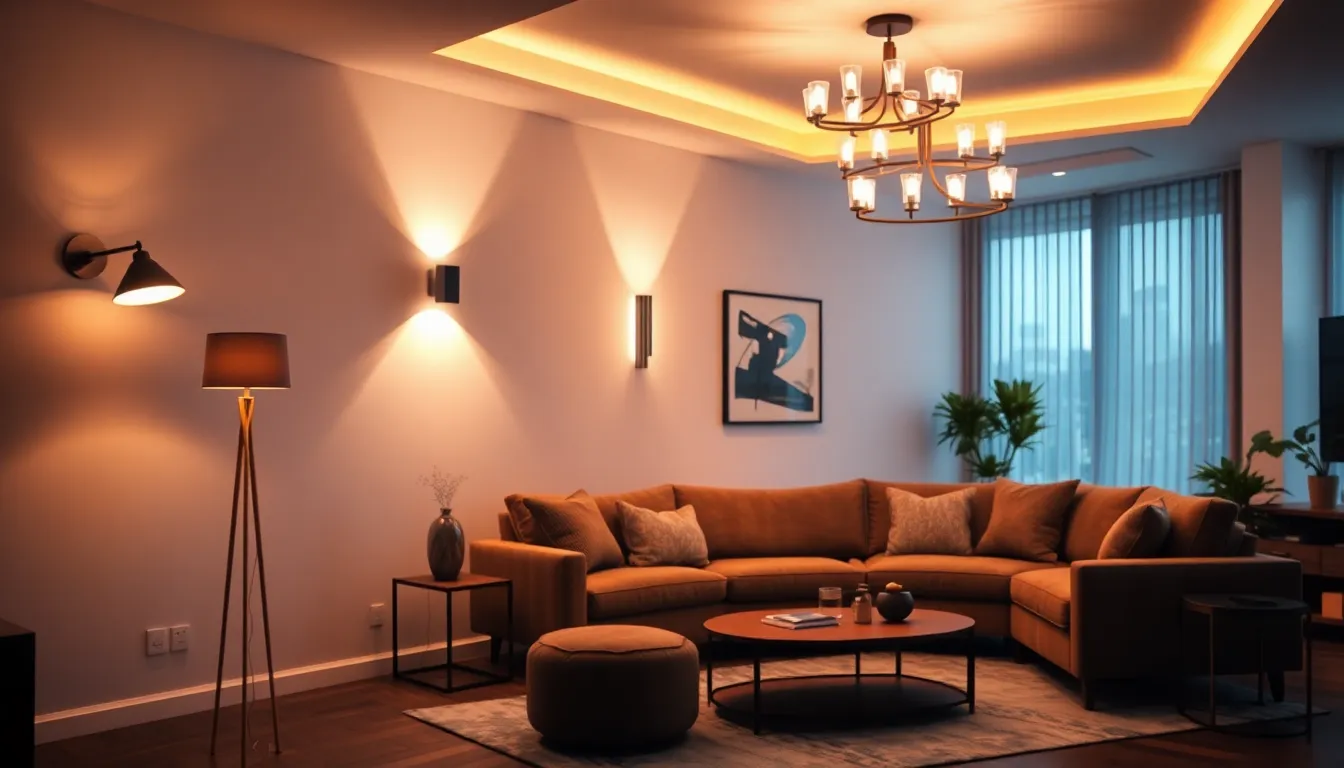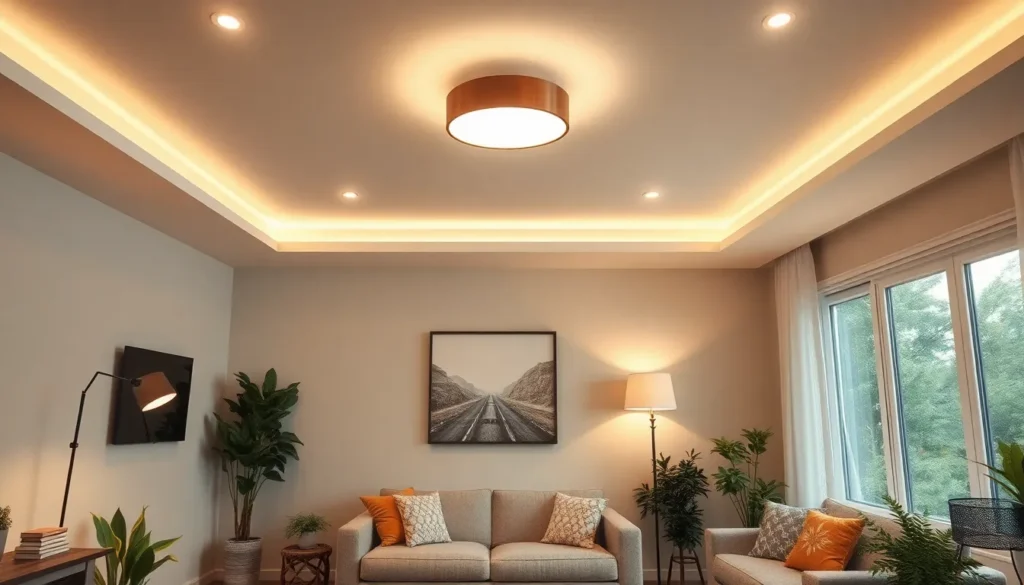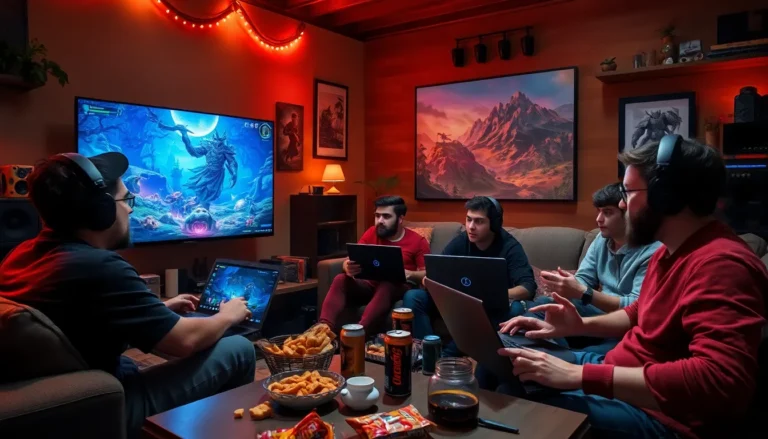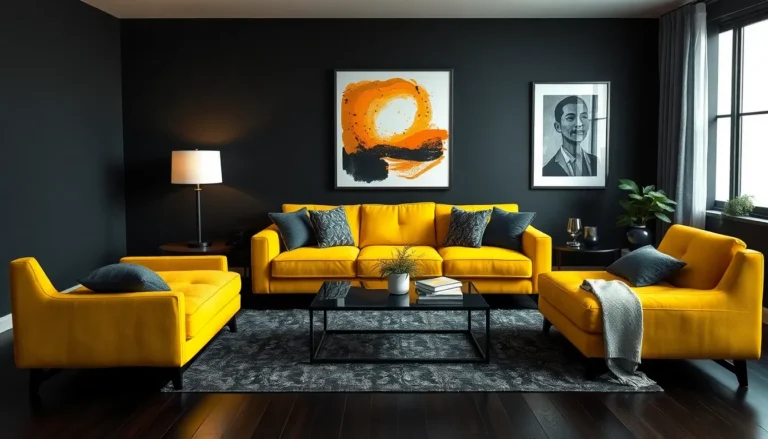Table of Contents
ToggleLED lights have transformed the way people illuminate their living spaces, offering a blend of style and energy efficiency. As homeowners seek to create inviting atmospheres, LED lighting provides endless possibilities for design and functionality. With various colors and intensities, these lights can enhance the mood of any room, making it a perfect setting for relaxation or entertainment.
In the living room, where families gather and memories are made, choosing the right lighting is essential. LED lights not only reduce energy consumption but also come in sleek designs that complement modern decor. Whether it’s through accent lighting or ambient glow, incorporating LED solutions can elevate the aesthetic and practicality of the space. Discover how to harness the power of LED lights to transform a living room into a cozy haven.
Benefits of LED Lights in Living Room
LED lights offer significant advantages when enhancing the living room’s ambiance. Their unique qualities contribute to both a visually appealing and functional space.
Energy Efficiency
Energy efficiency characterizes LED lights, consuming up to 80% less electricity than traditional incandescent bulbs. This efficiency not only lowers energy bills but also reduces the overall carbon footprint. For example, replacing a 60-watt incandescent bulb with a 10-watt LED can save approximately $50 over the bulb’s lifespan. Homeowners enjoy bright lighting while benefiting from substantial cost savings.
Longevity and Durability
Longevity and durability distinguish LED lights from other lighting options. With an average lifespan of 15,000 to 50,000 hours, LED bulbs can last up to 25 times longer than incandescent bulbs, which typically last around 1,000 hours. Higher durability comes from their solid-state technology, making them resistant to breaks and failures. Homeowners gain the advantage of less frequent replacements, leading to less waste and enhanced convenience.
Types of LED Lights for Living Rooms

Various types of LED lights enhance the living room’s ambiance and functionality. These options include ceiling fixtures, floor lamps, and wall sconces, each offering unique benefits.
Ceiling Fixtures
Ceiling fixtures provide uniform illumination and can act as central design elements in living rooms. Styles include flush mounts, chandeliers, and pendant lights. Flush mount LED lights offer a sleek look, perfect for lower ceilings. Chandeliers create a statement while providing ample lighting, ideal for larger spaces. Pendant lights can deliver targeted illumination in specific areas, such as over coffee tables or seating arrangements.
Floor Lamps
Floor lamps serve both decorative and functional purposes, with designs ranging from minimalist to modern. Adjustable floor lamps allow for customized lighting, suitable for reading or relaxing. Arc lamps can highlight specific areas of a room, creating cozy nooks for conversation. LED floor lamps use less energy than traditional options while offering a variety of color temperatures, from warm to cool white, catering to different preferences and activities.
Wall Sconces
Wall sconces add depth and character to living rooms through ambient or accent lighting. They can be installed at various heights to create visual interest, making them ideal for highlighting artwork or architectural features. LED sconces come in various designs, including retro and contemporary styles. Adjustable sconces allow users to direct light where needed, enhancing mood and functionality. Their compact size makes them suitable for smaller spaces or as complementary lighting in larger rooms.
Design Considerations
Designing an effective lighting scheme in the living room involves careful evaluation of brightness, color temperature, and dimming options. These factors influence both the visual appeal and functionality of the space.
Brightness and Color Temperature
Brightness and color temperature significantly impact the atmosphere of a living room. Brightness levels should accommodate the functions of the room, with soft lighting for relaxation and brighter settings for activities like reading or entertaining. A good brightness range is typically between 300 to 800 lumens for living rooms.
Color temperature adds another layer of customization. Warmer tones (2700K-3000K) create cozy environments, ideal for relaxed settings. Cooler tones (4000K-5000K) enhance alertness, suitable for task-oriented spaces. Mixing different color temperatures can achieve intricate effects, layering warmth with cooler accents for depth.
Dimming Options
Dimming options offer versatility and control over lighting intensity. Integrated dimmer switches allow users to adjust brightness based on mood or occasion, ranging from movie nights to lively gatherings. Many LED lights are compatible with dimmers, providing smooth adjustments without flickering.
Smart lighting solutions provide added convenience, enabling remote control of brightness and color via smartphone apps. This level of control facilitates customization based on time of day or specific activities, enhancing the living room experience.
Installation Tips
Proper installation of LED lights enhances their benefits significantly. Following effective strategies ensures optimal lighting and safety within the living room.
Placement Strategies
- Identify focal points: Position LED fixtures to accentuate architectural features, artwork, or furniture. This creates visual interest and depth.
- Create layers of light: Incorporate overhead fixtures, floor lamps, and wall sconces for diverse lighting layers. This approach balances general, task, and accent lighting effectively.
- Consider room activities: Place lights based on the room’s functions, ensuring brighter options in work or reading areas and softer lighting for relaxation zones.
- Test multiple configurations: Experiment with different placements before finalizing installations. Adjustments can enhance the overall ambiance significantly.
Wiring and Safety Considerations
- Follow manufacturer guidelines: Adhere to specific instructions regarding installation and connections to prevent hazards.
- Use appropriate rated materials: Select wiring and fixtures rated for LED applications. This ensures compatibility and optimal performance.
- Employ a licensed electrician: Consult professionals for complex installations or when modifying existing wiring. This ensures compliance with safety codes.
- Install proper circuit protection: Incorporate circuit breakers or fuses to safeguard against overloading, preventing potential fire hazards.
LED lights offer a transformative solution for living room illumination. Their ability to combine energy efficiency with aesthetic appeal makes them a preferred choice for homeowners. By selecting the right fixtures and adjusting brightness and color temperature, individuals can create a space that reflects their personal style while enhancing functionality.
The longevity and reduced energy consumption of LED lights not only lower bills but also contribute to a more sustainable environment. With various options available, from ceiling fixtures to wall sconces, there’s no shortage of ways to incorporate LED lighting into a living room design. Embracing these innovative solutions can lead to a cozy and inviting atmosphere perfect for any occasion.







